College aantekeningen
Lecture notes for the second exam of Sensation & Perception
- Instelling
- Universiteit Utrecht (UU)
This document contains all lecture notes for the second exam of the course Sensation & Perception at Utrecht University.
[Meer zien]













